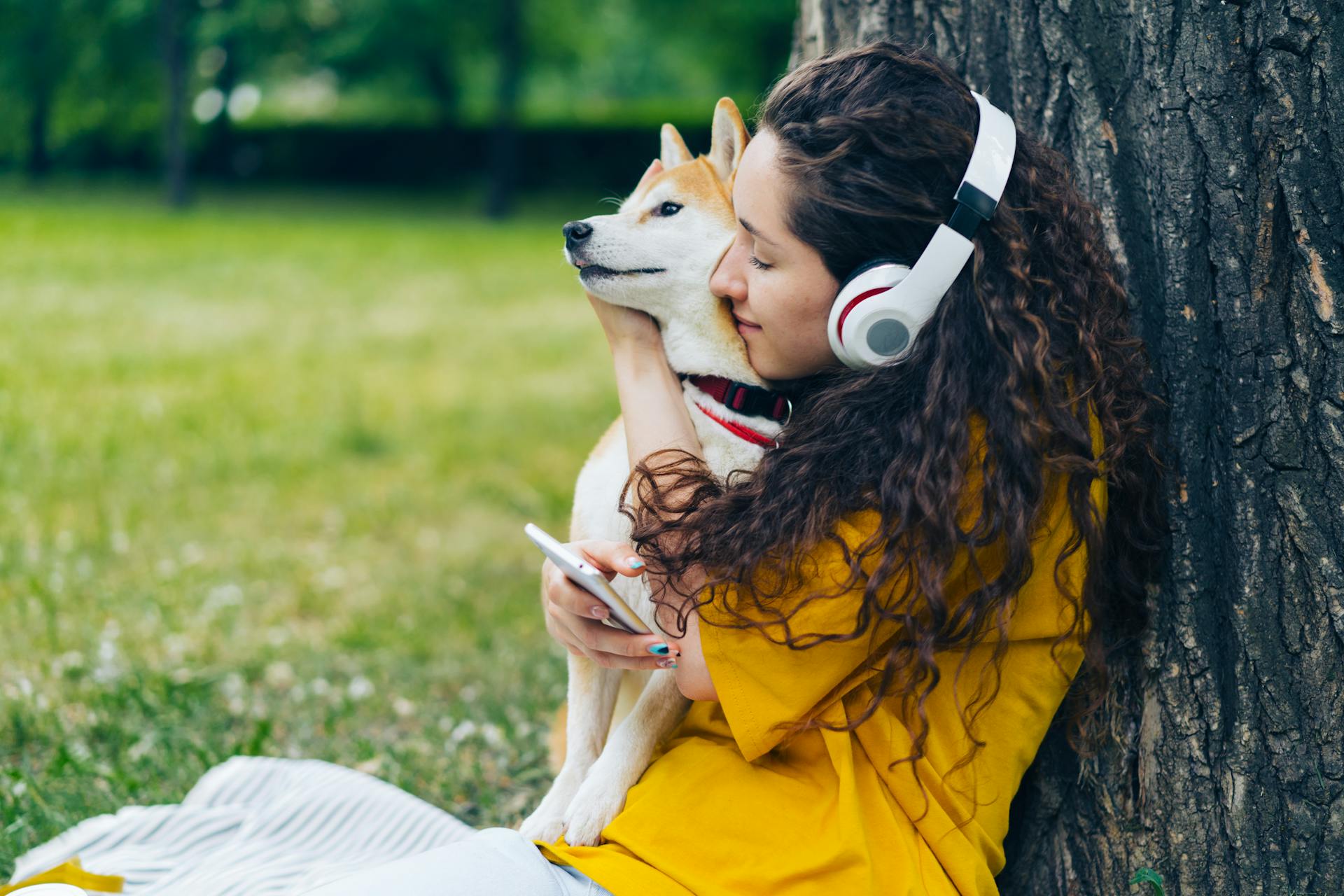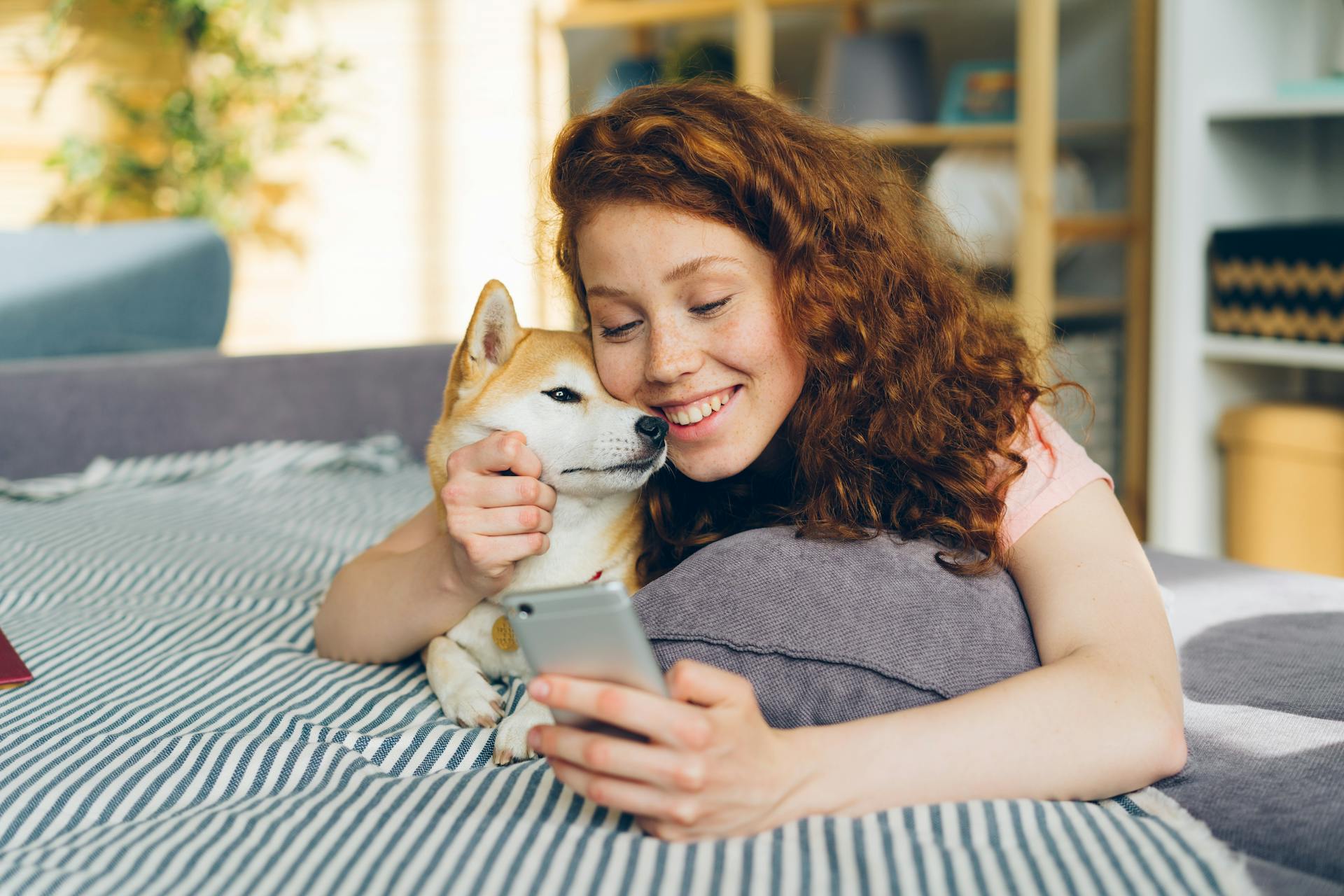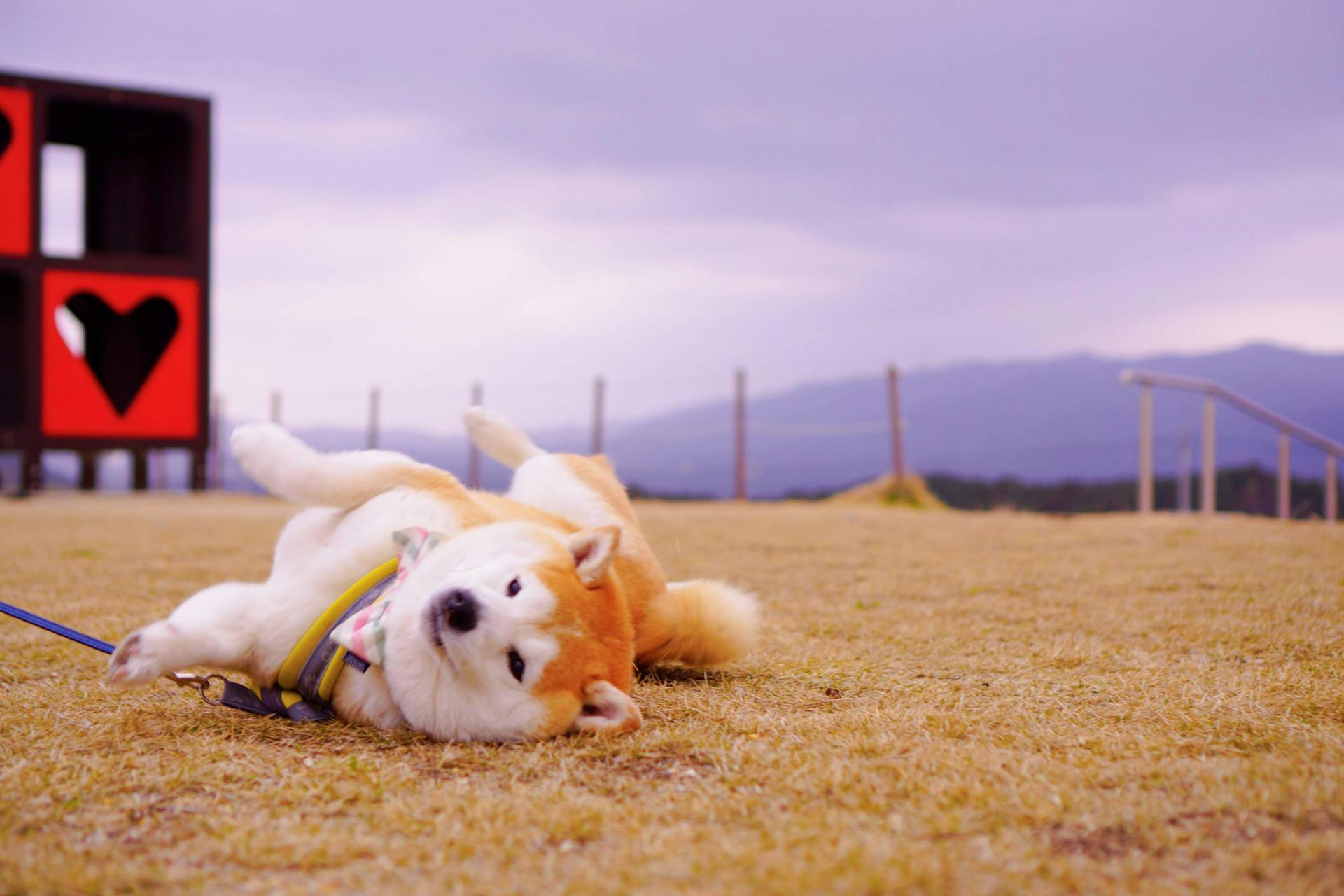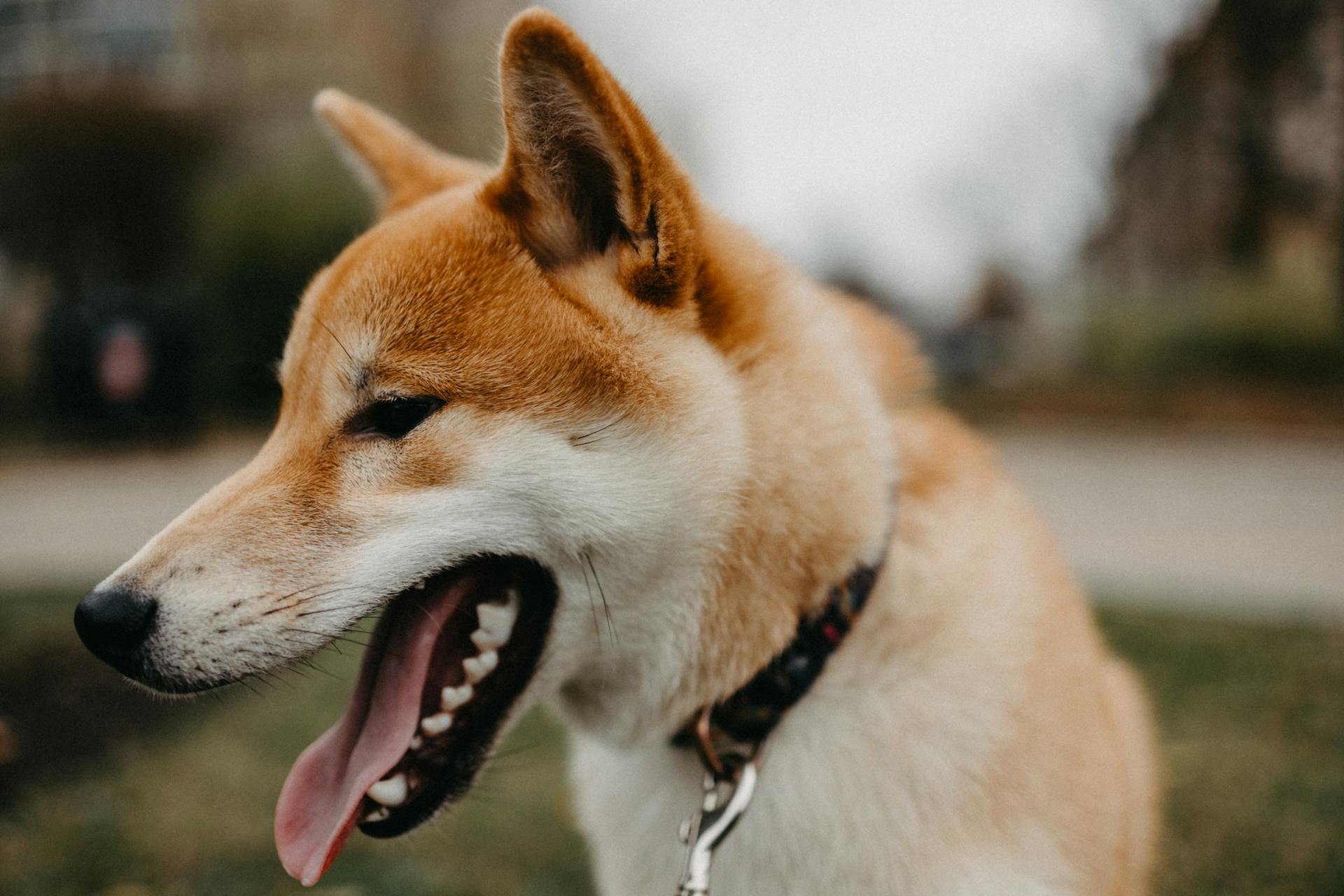
The Shiba Inu's rich history is deeply rooted in Japanese culture. The breed originated in Japan over 3,000 years ago, specifically on the island of Honshu.
The Shiba Inu's name is derived from the Japanese word "shiba", which means "brushwood" or "small shrub", likely referring to the breed's original habitat in the dense forests of Japan. They were highly valued by Japanese hunters and nobles.
In Japanese culture, the Shiba Inu is considered a symbol of loyalty and fidelity. The breed's ability to hunt and track small game made them a prized possession among Japanese hunters.
Take a look at this: Akitas in Japan
History and Culture
The Shiba Inu has a rich history that spans thousands of years, with evidence of dogs with a similar appearance to the Shiba Inu dating back to the prehistoric Jōmon period of Japanese history.
The breed was originally bred to hunt small game, such as birds and rabbits, in the mountainous areas of the Chūbu region. The Shiba Inu was a vital part of Japanese hunting culture, and its name is often associated with the brushwood bushes where they hunted.
You might enjoy: Shiba Inu Highest Market Cap
The Shiba Inu nearly became extinct during World War II due to food shortages and distemper outbreaks, but thanks to the efforts of hunters and intellectuals, the breed was preserved. Today, the Shiba Inu is recognized as a Natural Monument of Japan and is highly valued as a companion dog.
The breed's unique characteristics, such as its solid undercoat and curled tail, were preserved through careful breeding programs. The three surviving bloodlines, the Shinshu Shiba, Mino Shiba, and San'in Shiba, were combined to create the modern Shiba Inu breed.
Recognised as a National Treasure of Japan
The Shiba Inu is a beloved breed in Japan, and its rich history is a testament to its importance in the country's culture. The Shiba Inu was recognized as a national treasure of Japan in December 1936.
This designation was a result of the efforts of the Nihon Ken Hozonkai, the Association for the Preservation of the Japanese Dog. The breed's unique characteristics and its role in Japanese history made it a valuable part of the country's cultural heritage.
Expand your knowledge: Shiba Ken Japan
The Shiba Inu's recognition as a national treasure was a significant milestone in its history, and it has since become an iconic symbol of Japan. Its popularity has grown globally, and it's now widely recognized as a beloved breed around the world.
The Shiba Inu's unique features, such as its fox-like face and curled tail, have captivated many dog lovers. Its intelligence, loyalty, and independence have made it a popular choice as a companion animal.
Today, the Shiba Inu is still revered in Japan as a national treasure, and its breed standard is carefully maintained by the Japanese Kennel Club and the Federation Cynologique Internationale.
See what others are reading: Shiba Inu Price Japan
Sagamihara
Sagamihara is a city in Japan where you can see a piece of history up close. Only around 300 of the Jomon Shibas exist as of 2018.
You can visit The Life Museum at Azabu University in Sagamihara to see a taxidermy of a modern-day Jomon Shiba alongside its skeleton. This display shows how similar these replica dogs are to their prehistoric inspiration.
Sanin

The Sanin Shiba Inu is a remarkable breed that originated from the Inaba Inu of Tottori Prefecture and the Sekishu Inu of Shimane Prefecture. Both of these breeds were endangered due to the increase of western dogs.
In the early Showa period, a former landowner in Tottori prefecture, Masumi Ozaki, started preservation breeding to prevent the loss of local breeds. This effort was crucial in saving the Sanin Shiba Inu from extinction.
The breeding projects were severely impacted by World War II, with the number of dogs decreasing from 50 to 20 due to the use of dogs for fur by the military. This was a devastating blow to the preservation efforts.
In 1947, the two breeds were bred together to create the foundation stock of the Sanin Shiba Inu, a move that helped to protect the breed. The numbers were still low, but the Ozaki family continued to carry on preservation activities.
The Sanin Shiba Inu faced further threats in the 1950s and 60s, including two outbreaks of distemper that killed many dogs in Tottori prefecture. The Great Tottori Fire also discouraged preservation efforts during this time.
Related reading: Japanese Dogs Breeds
In Popular Culture

The Shiba Inu breed has made a significant impact on popular culture, particularly in Japan and online. They've become internet sensations, with one Shiba Inu named Kabosu being the face of the Doge meme, which originated in 2013.
The Doge meme features Kabosu and broken English, and it's had a lasting impact on internet culture. It's even inspired a cryptocurrency, Dogecoin, which uses Kabosu's image as its logo.
Another cryptocurrency, Shiba Inu, is also named after the breed. The Shiba Inu breed has been a part of online culture since at least 2010, according to Jamie Cohen, an assistant professor of media studies at Queens College of the City University of New York.
The Shiba Inu breed has also been the subject of various memes, often referred to as "Shibe." One notable example is a dog named Cheems, who gained worldwide attention during the COVID-19 pandemic and sadly passed away in 2023 at the age of 12½ years.
Here are some fun facts about the Shiba Inu breed's online presence:
- Dog breeds originating in Japan
- FCI breeds
- Spitz breeds
Physical Characteristics
The Shiba Inu's physical characteristics are truly one-of-a-kind. Their compact frame is well-suited for agility and endurance.
Their double coat is made up of stiff and straight guard hairs that stand off the body, protecting their skin and repelling rain or snow. The guard hairs are about 4 to 5 cm (1+1⁄2 to 2 in) long at the withers.
The Shiba Inu's tail hair is slightly longer and stands open in a brush, making their tails a defining characteristic.
Here are the specific areas where the urajiro (cream to white ventral color) is required on all coat colors:
- On the sides of the muzzle
- On the cheeks
- Inside the ears
- On the underjaw and upper throat
- Inside of legs
- On the abdomen
- Around the vent
- On the ventral side of the tail
Appearance
The Shiba Inu's compact frame is a result of well-developed muscles.
Their double coat is a distinctive feature, with a stiff and straight outer coat and a soft and thick undercoat.
The guard hairs stand off the body, protecting the underlying skin and repelling rain or snow, and are about 4 to 5 cm long at the withers.
Curious to learn more? Check out: Shiba Inu Coat
Their foxlike face, ears, and legs have short and even fur.
The tail hair is slightly longer and stands open in a brush, making their tails a defining characteristic.
The cream color is considered a major fault by the Japan Kennel Club and American Kennel Club, as the required markings known as "urajiro" are not visible.
The urajiro is a cream to white ventral color that is required in specific areas on all coat colors.
Here are the areas where urajiro is required:
- Sides of the muzzle
- Cheeks
- Inside the ears
- Underjaw and upper throat inside of legs
- Abdomen
- Around the vent and the ventral side of the tail
Note that the British Kennel Club breed standard allows for a white (cream) coat, whereas the Japan Kennel Club and American Kennel Club consider it a major fault.
Dog
A dog's height is a notable characteristic. Jōmon Era dogs measured between 40 and 47 centimetres tall to the withers.
Their facial structure is quite unique. Jōmon dogs had a very shallow stop, resulting in no discernible brow ridge.
Shiba dogs have a similar slender face, resembling that of a wolf or a fox.
A fresh viewpoint: Dogs Similar to Shiba Inu
Temperament and Personality
The Shiba Inu's temperament is a unique blend of independent spirit and proud nature, with a strong will and confidence that can sometimes make them stubborn. They are fiercely proud and have a spirited boldness that's hard to ignore.
Shibas are fastidious and take great care to keep themselves clean, often licking their paws and legs like cats do. They're also relatively easy to housetrain, as they tend to maintain a clean state and will often housebreak themselves with minimal effort.
Their "shiba scream" is a distinguishing characteristic of the breed, a loud and high-pitched sound they produce when provoked or unhappy. This can be a challenge for inexperienced owners, as it's not always easy to know how to react.
Shiba Inus are loyal and affectionate with their family, but can be suspicious of strangers and tend to guard their food, toys, or territory aggressively. They also have a strong prey drive and may chase small animals if they see them as potential prey.
Discover more: Will Shiba Inu Reach 1 Cent
Puppies with nice temperaments are curious and playful, willing to approach people and be held by them. Meeting the parents and siblings can help evaluate the puppy's temperament and predict how they'll behave as adults.
Early socialization is crucial for Shiba Inus, as it helps them develop into well-rounded dogs. Enrolling them in puppy kindergarten and exposing them to various people, sights, and experiences can make a big difference in their behavior and personality.
Ownership and Care
Shiba Inus are known for being a relatively low-maintenance breed when it comes to grooming, requiring only occasional brushing and bathing.
Their short coats make them a great choice for people with busy schedules or those who don't enjoy frequent grooming sessions.
Suggestion: Shiba Inu Grooming
Grooming
Shiba Inus are very clean, so grooming needs will likely be minimal. They naturally tend to hate to be wet or bathed, thus, it is very important to get them accustomed when they are young.
Their coat is coarse, with the outer coat being 2.5 to 3.2 cm (1 to 1+1⁄4 in) long, and is naturally waterproof.
Shedding, also known as blowing coat, can be a nuisance and is heaviest during seasonal change and particularly during the summer season.
Daily brushing can temper this problem, making it a worthwhile habit to get into.
It is recommended that owners never shave or cut the coat of a Shiba Inu, as the coat is needed to protect them from both cold and hot temperatures.
Consider reading: Will Shiba Inu Reach 1 Cent by 2030
Owning Rare Dogs: Expectations
Owning a Shibahō-bred Shiba dog is a rare privilege, with only around 5,000 dogs of this breed in total.
These dogs are far fewer in number than ordinary Shibas, with only around 300 Shibahō dogs registered each year.
Becoming an owner is not a straightforward process, with waiting lists sometimes several years long due to limited availability.
The Japan Society for Preservation of the Natural-Monument Shiba-Dog is the simplest way to become an owner, but even then, puppies are not always available.
Owning a Shibahō-bred dog requires more than just providing a loving home, as owners may be asked to make their dogs available for breeding or dog show appearances.
This is a fair request, considering the miracle of being able to see and even live with dogs from the Jōmon Period, a feat that took seventy years to consolidate.
Frequently Asked Questions
What were Shibas bred to do?
Shiba Inus were originally bred to hunt and flush small game, such as birds and rabbits, in Japan's mountainous regions. Their unique skills made them valuable companions for hunters in the Chūbu region.
What are Shiba Inu dogs good for?
Shiba Inu dogs are bred for hunting, excelling at finding and retrieving small game and birds. Their natural alertness and agility make them well-suited for this purpose.
What breeds made the Shiba Inu?
The Shiba Inu is a combination of three original breeds: Mino, Sanin, and Shinshu. These breeds originated from different regions in Japan, including Tottori and Shimane prefectures.
What did Shiba Inus evolve from?
Shiba Inus originated from three distinct types: Mino, Sanin, and Shinshu, which were named after their respective regions of origin. The modern breed is most similar to the Shinshu type, with all three contributing to its evolution.
What is the history of the Shiba Inu hunting?
The Shiba Inu's hunting history dates back to the Jomon period (14,500 BC to 300 BC), where they were valued for their keen senses and ability to catch small game and assist in hunting larger prey. Originally kept for hunting, their skills and instincts remain a key part of their breed today.
Featured Images: pexels.com


